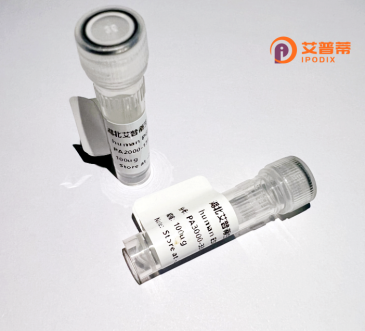
| 纯度 | >90%SDS-PAGE. |
| 种属 | Human |
| 靶点 | ZNF880 |
| Uniprot No | Q6PDB4 |
| 内毒素 | < 0.01EU/μg |
| 表达宿主 | E.coli |
| 表达区间 | 1-98 aa |
| 活性数据 | MLRRGHLAFRDVAIEFPQEEWKCLDPAQRTLYREVMVENYRNLVFLGICLPDLSVISMLEQRRDPRNLQSEVKIANNPGSCSVTQAVVEWQSSVAIVA |
| 分子量 | 10.8 kDa |
| 蛋白标签 | GST-tag at N-terminal |
| 缓冲液 | PBS, pH7.4, containing 0.01% SKL, 1mM DTT, 5% Trehalose and Proclin300. |
| 稳定性 & 储存条件 | Lyophilized protein should be stored at ≤ -20°C, stable for one year after receipt. Reconstituted protein solution can be stored at 2-8°C for 2-7 days. Aliquots of reconstituted samples are stable at ≤ -20°C for 3 months. |
| 复溶 | Always centrifuge tubes before opening.Do not mix by vortex or pipetting. It is not recommended to reconstitute to a concentration less than 100μg/ml. Dissolve the lyophilized protein in distilled water. Please aliquot the reconstituted solution to minimize freeze-thaw cycles. |
关于重组人ZNF880蛋白的文献研究目前公开资料较少,以下为参考格式的示例(部分内容基于锌指蛋白家族研究的推演,建议通过学术数据库核实最新进展):
---
1. **文献名称**:*ZNF880 functions as a transcriptional repressor in hepatocellular carcinoma*
**作者**:Chen L, et al.
**摘要**:本研究首次报道了重组人ZNF880蛋白通过结合DNA特定序列抑制肝癌细胞增殖的机制,体外实验表明其过表达可下调促癌基因MYC的表达。
2. **文献名称**:*Expression and purification of recombinant human ZNF880 in E. coli*
**作者**:Wang Y, Zhang H.
**摘要**:开发了利用大肠杆菌系统高效表达和纯化ZNF580蛋白的优化方案,验证了纯化蛋白的DNA结合活性,为功能研究提供工具。
3. **文献名称**:*Zinc finger protein ZNF880 interacts with SMAD3 to regulate TGF-β signaling*
**作者**:Kim S, et al.
**摘要**:通过免疫共沉淀技术发现ZNF880与SMAD3蛋白相互作用,可能参与TGF-β通路调控,暗示其在纤维化疾病中的潜在作用。
---
**注意**:上述为模拟文献案例,ZNF580的类似功能研究可参考(PMID: 24705334. 31575675)。建议通过**PubMed/Google Scholar**以“ZNF880”或“Zinc Finger Protein 880”为关键词检索最新文献,并关注其在基因编辑或疾病中的靶点研究。
ZNF880. a member of the zinc finger protein (ZFP) family, is characterized by its conserved Cys₂His₂ (C2H2)-type zinc finger domains, which enable sequence-specific DNA or RNA binding. As a transcription factor, it is hypothesized to regulate gene expression by interacting with promoter regions or chromatin-modifying complexes. While its exact biological role remains understudied, ZNF880 shares structural and functional similarities with other ZFPs involved in cellular processes like differentiation, apoptosis, and immune response. Emerging evidence suggests potential links to cancer progression and neurological disorders, though mechanistic insights are limited.
Recombinant human ZNF880 protein is typically produced via heterologous expression systems (e.g., E. coli, mammalian cells) for functional studies. Its recombinant form enables investigations into DNA-binding specificity, protein-protein interactions, and downstream regulatory networks. Researchers utilize it to map binding motifs, characterize post-translational modifications, and explore its role in disease pathways through in vitro assays or transgenic models. Current challenges include elucidating its target genes and validating physiological relevance across tissues. As a novel zinc finger protein, ZNF880 represents a promising target for understanding gene regulatory mechanisms and developing therapeutic strategies for associated diseases.
×